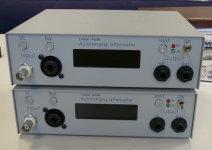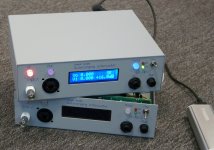Hi HpW, Please do.
-Chris
Thread about DIY talk's on RME ADI-2 Pro
There we go http://www.diyaudio.com/forums/equipment-tools/301013-diy-talks-rme-adi-2-pro.html#post4923610
Hp
A pair ready for shipment to the beta testers. I actually made my self-imposed deadline 'end of 2016'
Jan
Congratulations, Jan.
I wish I could always make my self-imposed deadlines
Cheers,
Bob
Status update: two complete units send out for beta-testing.
In the mean time, you can download the preliminary User Guide here to get a feel for the operation of the unit.
Comments invited!
Jan
In the mean time, you can download the preliminary User Guide here to get a feel for the operation of the unit.
Comments invited!
Jan
Attachments
I still have to put a spec sheet together, but so far I have:
- a few Hz to 100kHz within +/-0.1dB;
- THD around -118dB (best I could measure with a Sys2722 so could be less);
- Vin max 100VRMS, gain range -40dB to +16dB in 4dB steps at also 0.1dB accuracy.
- The level display is accurate (after calibration) to better than 1%.
There's no minimum level but at +16dB for 1V out the input level is around 160mV IIRC.
Jan
- a few Hz to 100kHz within +/-0.1dB;
- THD around -118dB (best I could measure with a Sys2722 so could be less);
- Vin max 100VRMS, gain range -40dB to +16dB in 4dB steps at also 0.1dB accuracy.
- The level display is accurate (after calibration) to better than 1%.
There's no minimum level but at +16dB for 1V out the input level is around 160mV IIRC.
Jan
Last edited:
Two units are in beta test with a few people. I am getting some feedback with recommended changes, in particular on the data displayed.
There may also be a review in an audio journal.
I expect to start the Kickstarter start of the summer.
It has taken a bit longer than I expected but functionally it is done and works as expected.
Jan
There may also be a review in an audio journal.
I expect to start the Kickstarter start of the summer.
It has taken a bit longer than I expected but functionally it is done and works as expected.
Jan
RE output levels. There are several considerations/aspect to this. First the level to get 0dBFS is not consistent between cards. The pro cards tend to use -10 or +4. Consumer card anywhere from .5v or less (mike in) to 2V +.
The other issue is that the ADC's best performance is not at max in. Typically its -10 to -20 dBFS. I find that this is not a major limitation with the better sound cards. I use a higher resolution FFT which looks deeper into the noise. It will also permit testing with higher crest factor waveforms like IM testing. Essentially this is around 250 mV. on a 2V 0dBFS card. The same is also true of the DAC source usually.
Use the balanced to balanced-differential connection to get the best isolation from noise sources.
The other issue is that the ADC's best performance is not at max in. Typically its -10 to -20 dBFS. I find that this is not a major limitation with the better sound cards. I use a higher resolution FFT which looks deeper into the noise. It will also permit testing with higher crest factor waveforms like IM testing. Essentially this is around 250 mV. on a 2V 0dBFS card. The same is also true of the DAC source usually.
Use the balanced to balanced-differential connection to get the best isolation from noise sources.
RE output levels. There are several considerations/aspect to this. First the level to get 0dBFS is not consistent between cards. The pro cards tend to use -10 or +4. Consumer card anywhere from .5v or less (mike in) to 2V +.
The other issue is that the ADC's best performance is not at max in. Typically its -10 to -20 dBFS. I find that this is not a major limitation with the better sound cards. I use a higher resolution FFT which looks deeper into the noise. It will also permit testing with higher crest factor waveforms like IM testing. Essentially this is around 250 mV. on a 2V 0dBFS card. The same is also true of the DAC source usually.
Use the balanced to balanced-differential connection to get the best isolation from noise sources.
Demian, that is good info, for some reason I have been working with 1V as sound card sweet spot. BTW you could verify your sample by inserting 1V so it ranges to 0dB, then pressing Hold so it won't switch and then check with .5 or .25V.
I will look into setting the sweet spot much lower but it might need a hardware mod. If 0.25 is the sweet spot, the range of -40dB to +16dB should probably be shifted downwards.
Another question is what such a low sweet spot would mean for the SNR.
Jan
I find the EMU-0204 sweet spot is .5V or less (input). Best SNR in this range. I have three steps to my passive divider that keeps the level between .3 and .5V. This allows testing of high power (200-400Watts) amplifiers without any issues.
Also supporting what Demian said about the output of the sound cards.
Also supporting what Demian said about the output of the sound cards.
Demian, that is good info, for some reason I have been working with 1V as sound card sweet spot. BTW you could verify your sample by inserting 1V so it ranges to 0dB, then pressing Hold so it won't switch and then check with .5 or .25V.
I will look into setting the sweet spot much lower but it might need a hardware mod. If 0.25 is the sweet spot, the range of -40dB to +16dB should probably be shifted downwards.
Another question is what such a low sweet spot would mean for the SNR.
Jan
Jan have you considered small plug in board. I made a filter board years ago where the tuning resistors plugged into an IC socket. You could do something similar for scaling.
Of course this won't help if you already have boards made up.
- Home
- Design & Build
- Equipment & Tools
- Autoranger for soundcards

